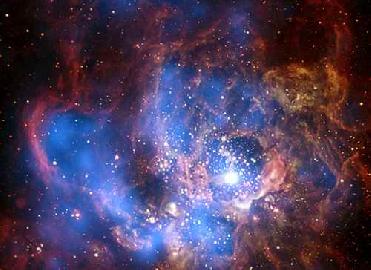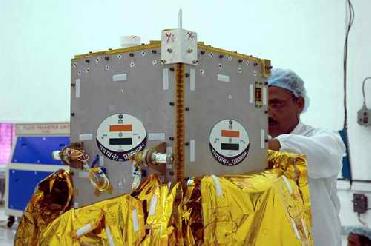
This composite image from Chandra X-ray Observatory data (colored blue), combined with optical light data from the Hubble Space Telescope (red and green), shows a divided neighborhood where some 200 hot, young, massive stars reside. Credit: X-ray: NASA/CXC/CfA/R. Tuellmann et al.; Optical: NASA/AURA/STScI
WASHINGTON (BNS): A new study led by Ralph Tuellmann of the Harvard Smithsonian Center for Astrophysics has discovered NGC 604, the largest region of star formation in the nearby galaxy M33. This discovery is the first deep, high-resolution view seen from Chandra X-ray Observatory data.
Those images combined with optical light data from the Hubble Space Telescope gives a picture of a divided neighbourhood where some 200 hot, young, massive stars reside, the study said.
Throughout the cosmic metropolis, giant bubbles in the cool dust and warm gas are filled with diffuse, multi-million degree gas that emits X-rays. Scientists think these bubbles are generated and heated to X- ray temperatures when powerful stellar winds from the young massive stars collide and push aside the surrounding gas and dust. So, the vacated areas are immediately repopulated with the hotter material seen by Chandra, the study noted.
Scientists said that there was a difference between the two sides of this bifurcated stellar city. They said that on the western (right) side of the wall, the amount of hot gas found in the bubbles corresponds to about 4300 times the mass of the sun. This value and the brightness of the gas in X-rays imply that the western part of NGC 604 is entirely powered by winds from the 200 hot massive stars, they said.
The scientists said that this find was interesting as through previous models the bubbles were predicted to be fainter than observed, so that additional heating from supernova remnants was required. This means that in this area of NGC 604, none or very few of the massive stars must have exploded as supernovas, the researchers said.
The scientists compared the situation on the eastern (left) side of NGC 604 and found it was different. On this side, the X-ray gas contained 1750 times the mass of the sun and winds from young stars could not explain the brightness of the X-ray emission. The bubbles on this side appeared to be much older and were likely created and powered by young stars and supernovas in the past, they said.
A similar separation between east and west is seen in the optical results. This implies that a massive wall of gas shields the relatively quiet region in the east from the active star formation in the west, the study found.
The researchers conducted the study spread over 16 days of observation of M33 called the Chandra ACIS Survey of M33, or ChASeM33.
 Next Article
Next Article













The Indian Air Force, in its flight trials evaluation report submitted before the Defence Ministry l..
view articleAn insight into the Medium Multi-Role Combat Aircraft competition...
view articleSky enthusiasts can now spot the International Space Station (ISS) commanded by Indian-American astr..
view article